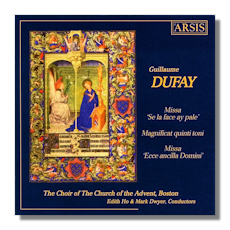
The Internet's Premier Classical Music Source
Related Links
- Dufay Reviews
- Latest Reviews
- More Reviews
-
By Composer
-
Collections
DVD & Blu-ray
Books
Concert Reviews
Articles/Interviews
Software
Audio
Search Amazon
Recommended Links
Site News
 CD Review
CD Review
Guillaume Dufay

- Mass "Missa Se la face ay pale"
- Mass "Missa Ecce ancilla Domini" *
- Magnificat quinti toni
Church of the Advent Choir/Edith Ho
* Church of the Advent Choir/Mark Dwyer
Arsis CD118
Guillaume Dufay (c.1400-1474) is one of those pivotal composers whose impact on musical style was so substantial that it's often hard to distinguish such influence from the changes that otherwise prevailed at the time. When compared with earlier styles, Dufay's polyphony is richer, sweeter and more adventurous. Such a contrast is based on three developments: the extension of the vocal range regularly to use a bass; longer works which required more intricate contrapuntal technique; and greater use of thirds and sixths. To the more casual listener Dufay's delicate yet insistent harmonies impress, as does the way in which his highly expressive melodies use perhaps more self-conscious phrasing in a style that we associate with the early Renaissance – despite the fact that the composer wrote all his works long before music printing was available.
On this highly enjoyable and stimulating CD from the ever-enterprising Choir of the Church of the Advent, Boston, Massachusetts, under conductors Edith Ho and Mark Dwyer, two major and lengthy (at just under 31 and 27½ minutes) masses are presented, Missa Se la face ay pale (conductor Ho) and Missa Ecce ancilla Domini (conductor Dwyer) with Dufay's Magnificat quinti toni (Ho) – much shorter at fewer than six minutes.
These masses are weighty pieces representative of Dufay's output; the recording would make an excellent introduction to the composer's work. Missa Se la face ay pale is from the middle of his career. It's based on the tenor of his secular song of the same name from the 1430s, although the mass itself dates from 20 years or so later. While originating in music for a wedding (both the song and, probably, the mass itself), it's not over-infused with jollity. Although the Choir here has no doubts about the positive and upbeat, not to mention uplifting, tone that must be used in order to reflect Dufay's intention carefully woven into the harmonies and melodies. This is never exaggerated in the Choir's account, though. A wonderful balance struck by the performers.
Missa Ecce ancilla Domini comes from later – probably around 1463; it's an Advent mass that shows the influence of Ockeghem, who has a mass of the same name. Again based on two different pieces of cantus firmus, the texture is more spare, thinner and seems more deliberately suited to communicating the text. It's not, though, in any way a superficial work, nor an overtly imitative one. Dwyer and the Choir imbue the Mass with life, vigor and impact. The fact that each movement begins similarly – with a duet between soprano and alto – brings a note of urgency to our perception. Perhaps this implies expectation, given the time in the liturgical year for which it was intended.
The Magnificat is briefer and consists of plainchant alternated with three part fauxbourdon polyphony. It too is performed with an insistent forward movement but which hasn't a hint of hurry. Placed between the two masses, it offers contrast – and in fact emphasizes their weight.
There are half a dozen or so other recordings of each of these two masses, although none in this combination. The version of Missa Se la face ay pale by Diabolus In Musica/Antoine Guerber (Alpha 116) and of Missa Ecce ancilla Domini by the Gilles Binchois Ensemble/Vellard (Virgin Classics Veritas 61818) are worth considering.
The present recordings, though, make excellent first choices. The delicacy yet the assuredness, the exactness of tempi yet the fluidity of interpretation make them exemplary in every way. There is a simple yet useful and to-the-point booklet. The Choir's usual venue, their own church, provides a healthy and memorable acoustic. It sets off this intricate and rich music, listening to which also has such a simple and forceful impact.
Copyright © 2009 by Mark Sealey




















